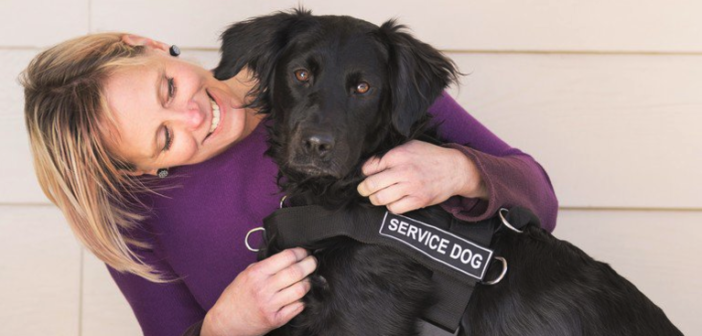Have you ever asked yourself what therapy dogs are all about? Maybe you’ve also wondered what service dogs do, and how the two differ. Today, I hope to shed a little light on the difference between the two. I do have some experience in this field, as I trained both service dogs and therapy dogs for the first three years of my career. After my three-year journey as a service dog trainer, I moved into the pet dog training world and taught therapy dog training classes for about 10 years.
Service dogs are actually categorized as assistance dogs, who are trained to provide a specific service to their personal handlers, improve the handler’s quality of life, and provide them with more independence. The three types of assistance dogs are guide dogs for the visually impaired, hearing dogs, and service dogs. In this article, I will discuss service dogs, since this seems to be the category people most often confuse with therapy dogs.
Service dogs are specially trained to help people with a variety of disabilities, including mobility and balance issues, seizure disorders, autism, and even some psychiatric disabilities. Service dogs perform specific tasks for their handler, such as opening doors, retrieving dropped items, alerting to seizures, and even activating medical alert boxes.
According to the Americans with Disabilities Act (ADA), “Service animals are defined as dogs that are individually trained to do work or perform tasks for people with disabilities. Examples of such work or tasks include guiding people who are blind, alerting people who are deaf, pulling a wheelchair, alerting and protecting a person who is having a seizure, reminding a person with mental illness to take prescribed medications, calming a person with Post Traumatic Stress Disorder (PTSD) during an anxiety attack, or performing other duties. Service animals are working animals, not pets. The work or task a dog has been trained to provide must be directly related to the person’s disability. Dogs whose sole function is to provide comfort or emotional support do not qualify as service animals under the ADA.”
Service dogs in the United States are granted full access to places that are open to the public, with few exceptions. According to the ADA, “It may be appropriate to exclude a service animal from operating rooms or burn units where the animal’s presence may compromise a sterile environment.” A service dog must also be under control at all times.
The take-home message about service dogs is that they are trained to do specific tasks for a specific individual as an accommodation for that person’s disability, in order to assist with that individual’s independence. Under United States law, they can accompany their handler in any public location, assuming they are under control at all times.
Therapy dogs, on the other hand, provide a different service than service dogs do. Unlike service dogs, therapy dogs are dogs who are trained to provide love, comfort, and sometimes entertainment to others, not just their handler. Therapy dogs often provide comfort in hospitals, schools, nursing homes, and during tragic events.
Unlike service dogs, the law does not give public access rights to therapy dogs. Therapy dogs are considered pets, and follow the same rules and guidelines as a pet dog. Therapy dog teams must therefore have prior agreements with any hosting facility, such as a school, nursing home, or hospital, in order to be granted visiting rights. Most of these will require some sort of therapy dog certification or registration prior to visits.
For more information on service dogs and therapy dogs, consult Assistance Dogs International, the Americans with Disabilities Act on Service Dogs, or this list of therapy dog organizations.
Many thanks to Tonya Wilhelm, author of the book Proactive Puppy Care, for her contributions to this piece.
Featured image: A service dog and her handler. This image, and all images in this story via ConsumersAdvocate.org.






